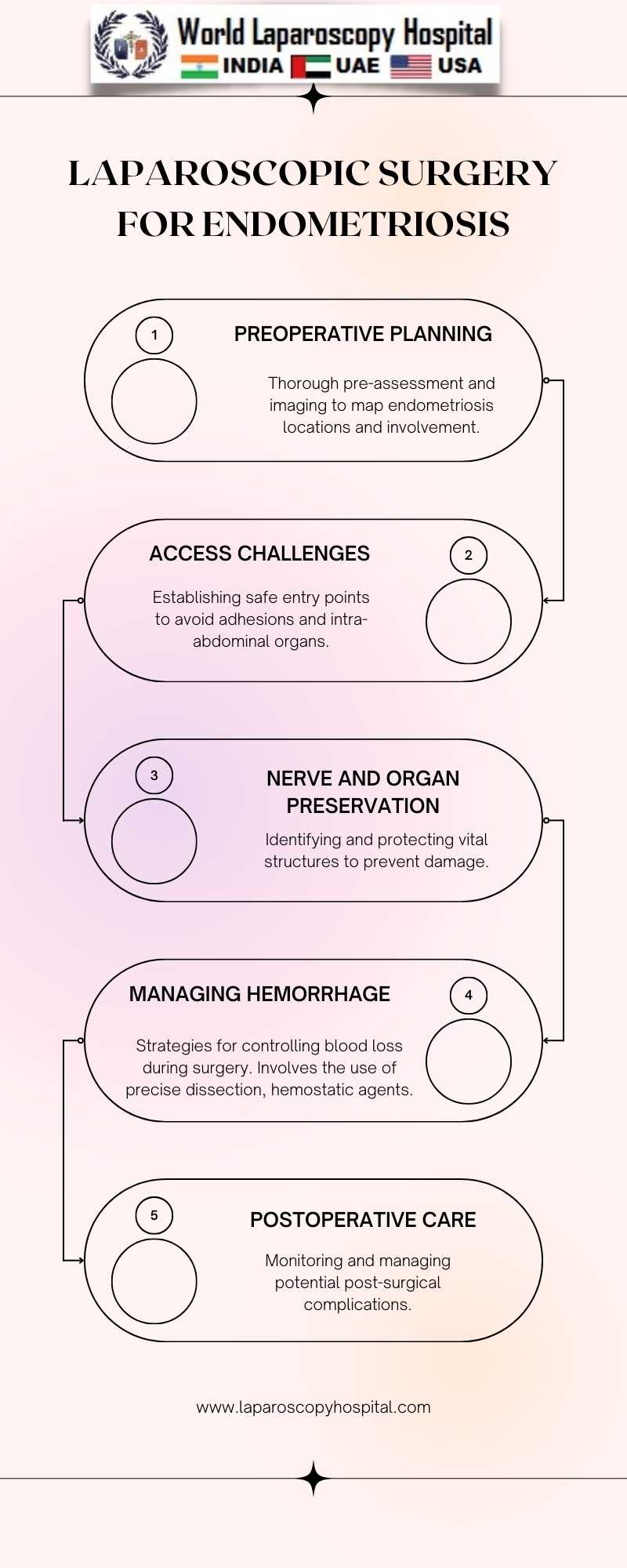Laparoscopic Surgery for Endometriosis: Managing Potential Complications
Laparoscopic surgery for endometriosis is a minimally invasive surgical procedure that has become the standard approach for diagnosing and treating endometriosis, a condition where tissue similar to the lining of the uterus grows outside the uterine cavity, causing pain and potentially leading to infertility. While this technique offers numerous advantages over traditional open surgery, such as reduced pain, shorter hospital stays, and quicker recovery times, it is not without potential complications. Managing these complications effectively is crucial for patient safety and optimal outcomes.

The onset of laparoscopic surgery marked a significant advancement in the field of gynecological surgery. By enabling surgeons to access the pelvic area through small incisions, it allows for detailed visualization and precise removal of endometriotic lesions with minimal disruption to surrounding tissues. However, the complexity of endometriosis, often involving multiple organs within the pelvic cavity, presents unique challenges and risks.
One of the primary potential complications is damage to surrounding organs. The proximity of the uterus, fallopian tubes, ovaries, bladder, and bowel to endometriotic lesions means there is a risk of accidental injury during dissection or removal of the lesions. Surgeons must have a deep understanding of pelvic anatomy and possess the skills to navigate these structures delicately. Intraoperative techniques such as hydrodissection, where fluid is used to separate tissues, and the use of energy devices with precision, can help minimize this risk.
Another concern is the potential for urinary tract injuries. The ureters, which run close to the female reproductive organs, can be damaged during the excision of endometriotic lesions, particularly in cases where the disease has caused anatomical distortions. Preoperative imaging, intraoperative identification of anatomical landmarks, and, if necessary, the use of stents can aid in the prevention of such injuries.
Bowel complications, including perforation, fistula formation, and bleeding, are among the more serious risks associated with laparoscopic surgery for endometriosis. These complications often arise during the removal of deep infiltrating endometriosis that involves the bowel. A multidisciplinary approach involving gynecologists and colorectal surgeons is recommended for complex cases to ensure comprehensive management and repair of any inadvertent bowel injuries.
Postoperative adhesions are also a significant concern. While laparoscopic surgery reduces the incidence of adhesions compared to open surgery, the risk cannot be entirely eliminated. The use of anti-adhesion barriers, gentle tissue handling, and minimizing tissue desiccation can help reduce the formation of postoperative adhesions.
Infection is a potential complication following any surgical procedure, including laparoscopic surgery for endometriosis. Proper surgical technique, the use of prophylactic antibiotics, and adherence to sterile protocols are essential in minimizing the risk of postoperative infections.
Hemorrhage is another risk associated with laparoscopic surgery for endometriosis. The pelvic area is highly vascular, and extensive dissection or removal of endometriotic lesions can lead to significant bleeding. Advanced surgical skills, the judicious use of hemostatic agents, and the availability of blood transfusion facilities are crucial for managing intraoperative bleeding.
Lastly, the psychological impact of surgery for endometriosis should not be overlooked. Patients may experience anxiety, depression, or post-traumatic stress disorder, especially in cases of chronic pain or infertility associated with endometriosis. Comprehensive patient care, including psychological support and counseling, is integral to the overall management strategy.
Conclusion
Laparoscopic surgery for endometriosis offers significant benefits but comes with potential complications that require careful management. A thorough understanding of the disease, expert surgical skills, and a multidisciplinary approach are essential for minimizing risks and ensuring the best possible outcomes for patients. Continuous advances in surgical techniques and technology, along with ongoing research into endometriosis, promise to further improve the safety and efficacy of laparoscopic surgery for this challenging condition.

The onset of laparoscopic surgery marked a significant advancement in the field of gynecological surgery. By enabling surgeons to access the pelvic area through small incisions, it allows for detailed visualization and precise removal of endometriotic lesions with minimal disruption to surrounding tissues. However, the complexity of endometriosis, often involving multiple organs within the pelvic cavity, presents unique challenges and risks.
One of the primary potential complications is damage to surrounding organs. The proximity of the uterus, fallopian tubes, ovaries, bladder, and bowel to endometriotic lesions means there is a risk of accidental injury during dissection or removal of the lesions. Surgeons must have a deep understanding of pelvic anatomy and possess the skills to navigate these structures delicately. Intraoperative techniques such as hydrodissection, where fluid is used to separate tissues, and the use of energy devices with precision, can help minimize this risk.
Another concern is the potential for urinary tract injuries. The ureters, which run close to the female reproductive organs, can be damaged during the excision of endometriotic lesions, particularly in cases where the disease has caused anatomical distortions. Preoperative imaging, intraoperative identification of anatomical landmarks, and, if necessary, the use of stents can aid in the prevention of such injuries.
Bowel complications, including perforation, fistula formation, and bleeding, are among the more serious risks associated with laparoscopic surgery for endometriosis. These complications often arise during the removal of deep infiltrating endometriosis that involves the bowel. A multidisciplinary approach involving gynecologists and colorectal surgeons is recommended for complex cases to ensure comprehensive management and repair of any inadvertent bowel injuries.
Postoperative adhesions are also a significant concern. While laparoscopic surgery reduces the incidence of adhesions compared to open surgery, the risk cannot be entirely eliminated. The use of anti-adhesion barriers, gentle tissue handling, and minimizing tissue desiccation can help reduce the formation of postoperative adhesions.
Infection is a potential complication following any surgical procedure, including laparoscopic surgery for endometriosis. Proper surgical technique, the use of prophylactic antibiotics, and adherence to sterile protocols are essential in minimizing the risk of postoperative infections.
Hemorrhage is another risk associated with laparoscopic surgery for endometriosis. The pelvic area is highly vascular, and extensive dissection or removal of endometriotic lesions can lead to significant bleeding. Advanced surgical skills, the judicious use of hemostatic agents, and the availability of blood transfusion facilities are crucial for managing intraoperative bleeding.
Lastly, the psychological impact of surgery for endometriosis should not be overlooked. Patients may experience anxiety, depression, or post-traumatic stress disorder, especially in cases of chronic pain or infertility associated with endometriosis. Comprehensive patient care, including psychological support and counseling, is integral to the overall management strategy.
Conclusion
Laparoscopic surgery for endometriosis offers significant benefits but comes with potential complications that require careful management. A thorough understanding of the disease, expert surgical skills, and a multidisciplinary approach are essential for minimizing risks and ensuring the best possible outcomes for patients. Continuous advances in surgical techniques and technology, along with ongoing research into endometriosis, promise to further improve the safety and efficacy of laparoscopic surgery for this challenging condition.
1 COMMENTS
Dr. K K Dwivedi
#1
Feb 16th, 2024 7:17 am
Laparoscopic surgery for endometriosis provides substantial advantages but necessitates vigilant complication management. Expertise, disease comprehension, and multidisciplinary collaboration mitigate risks, optimizing patient outcomes. Ongoing advancements in techniques and research offer promise for safer, more effective treatments.
| Older Post | Home | Newer Post |








